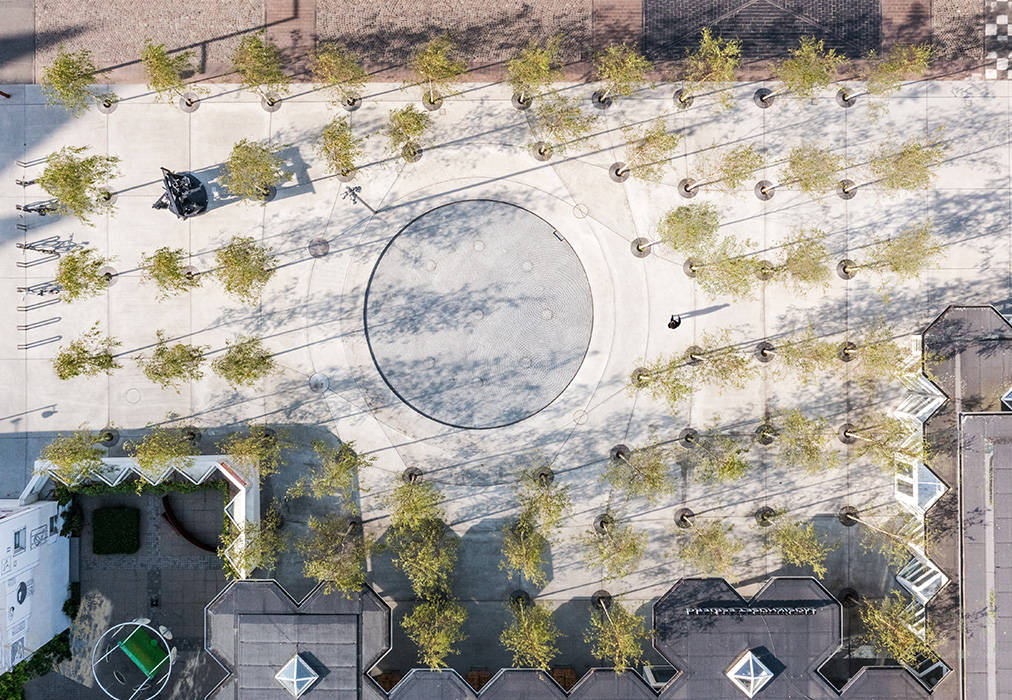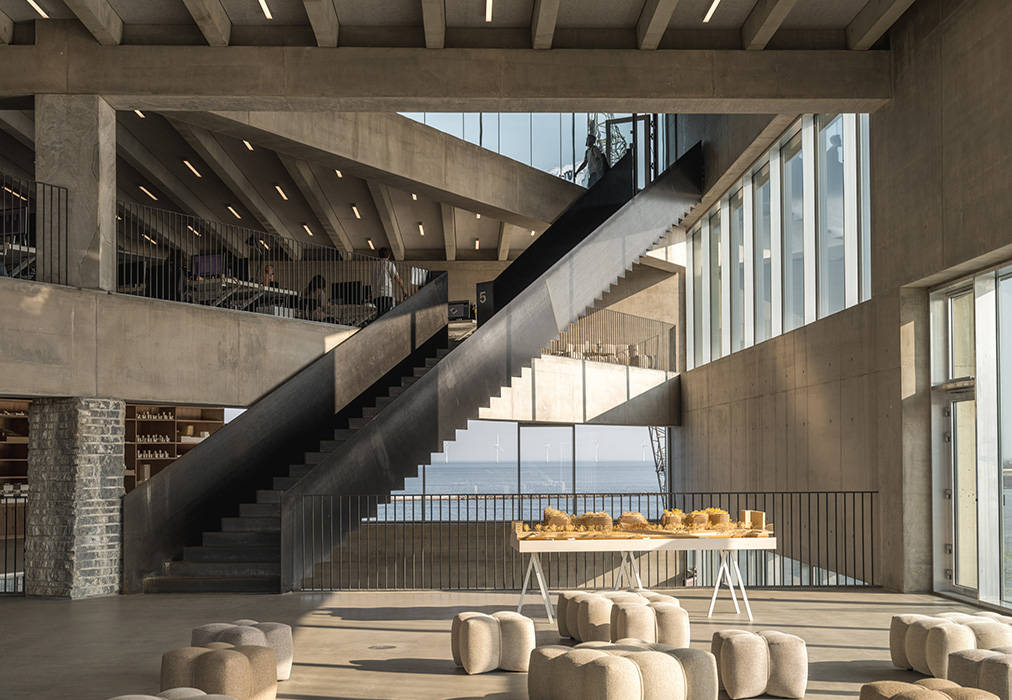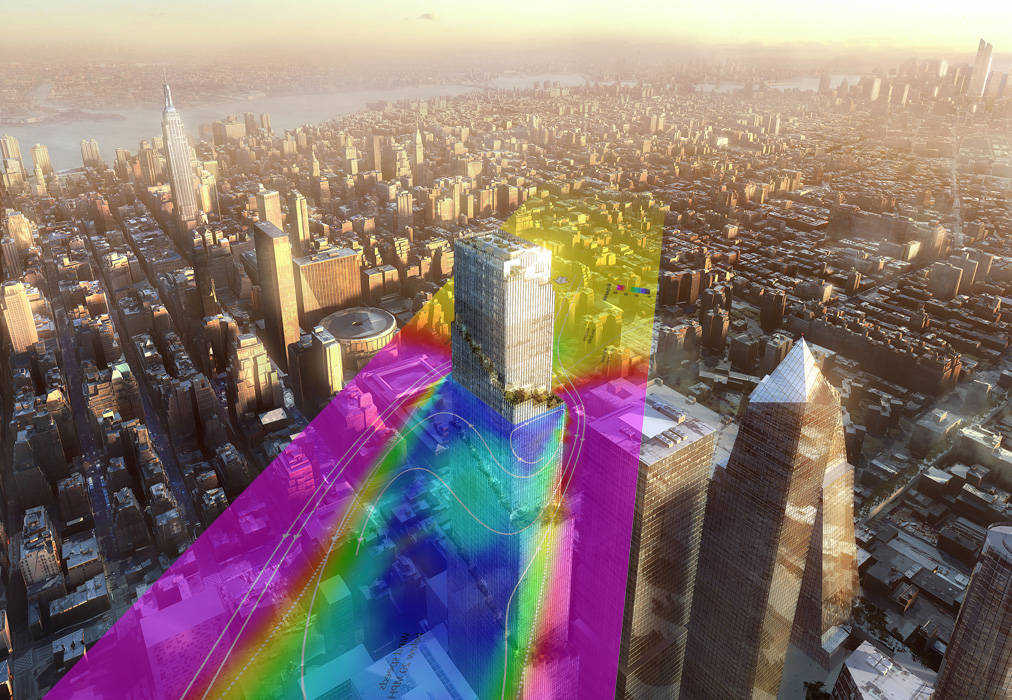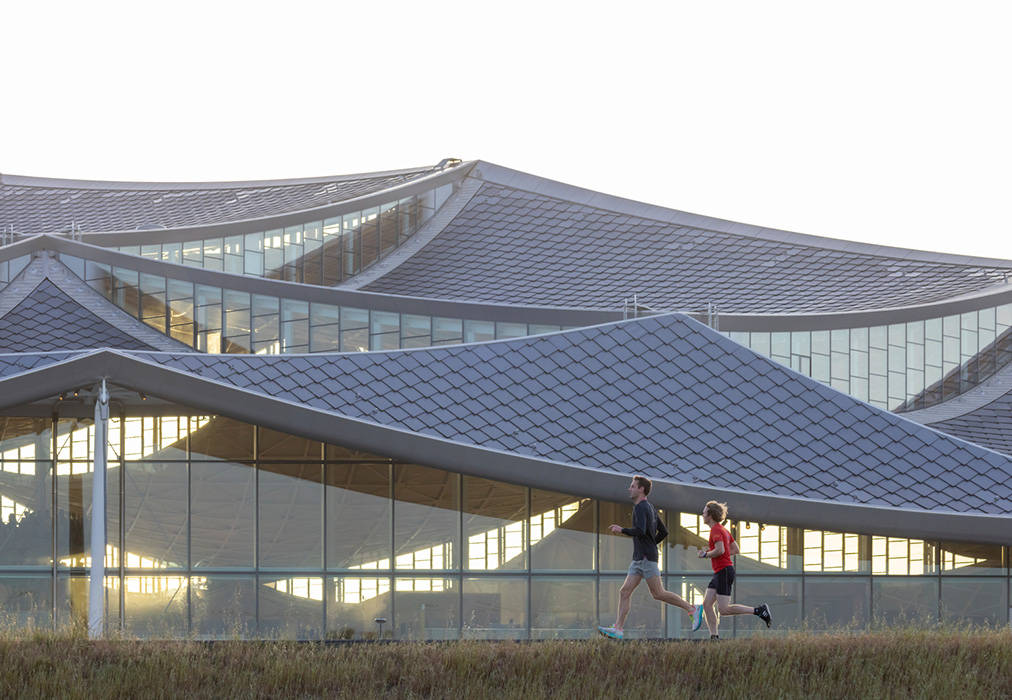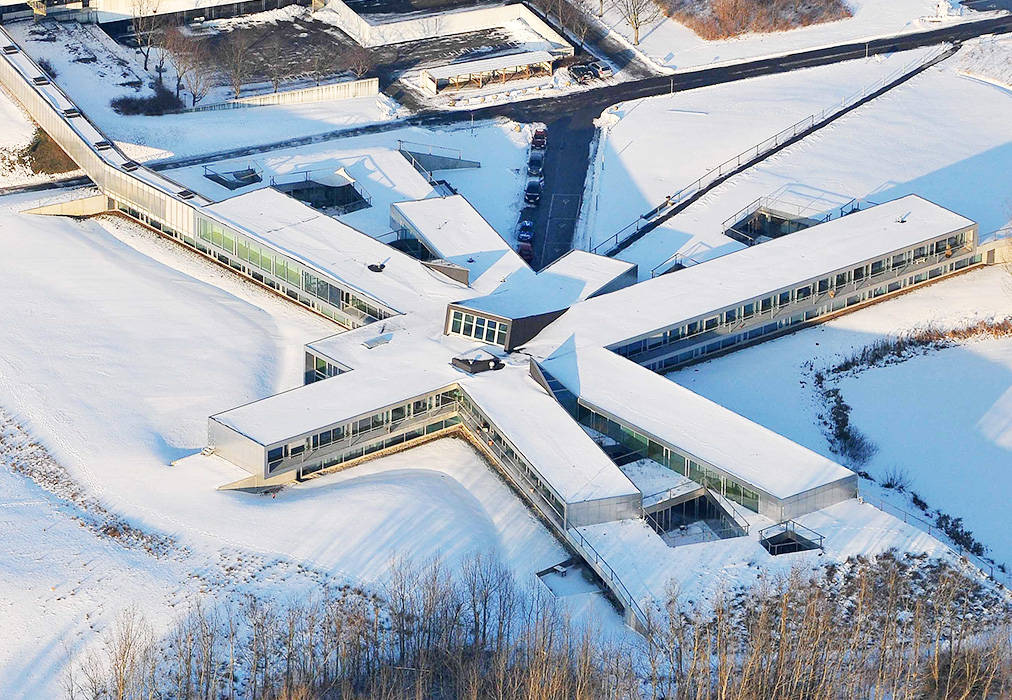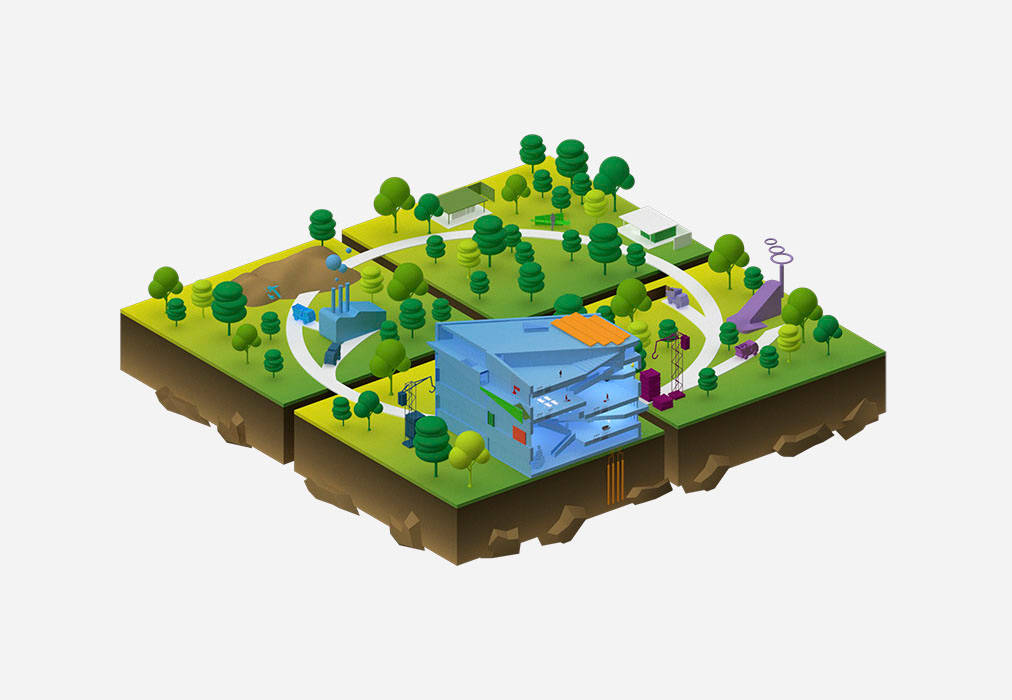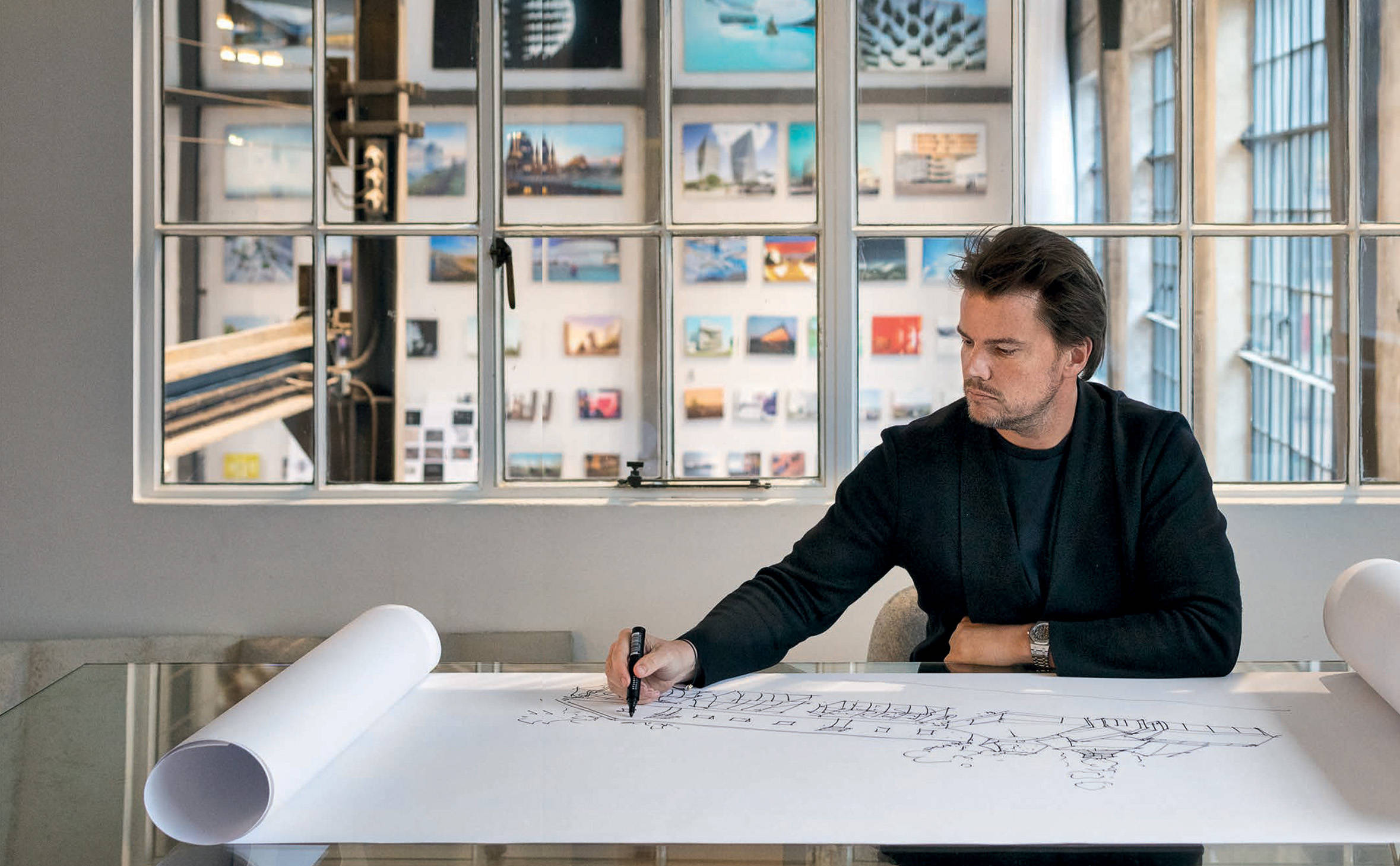
A new city square Henning Kruses Plads creates a more lively public realm in Denmark's fifth largest city, Esbjerg. The design brings together Esbjerg's old town center and the green city park around the local concert venue Musikhuset. The square is planted with 55 pollen-free Betula Pendula Birch, whose white stems blend with the white interior columns of the music venue. Planted in a grid system around a cymatic pool, the trees are all stemmed at a height of 4-5 m to ensure views in all directions.
Aarhus Harbor Bath is an extension of BIG’s current development plan for Aarhus’ new waterfront neighborhood named O4. Similar to BIG’s first harbor bath in Copenhagen from 2002 which has come to define the Danish capital as one of the most livable cities in the world, Aarhus Harbor Bath creates a more engaging and adventurous waterfront experience breathing new life into an area historically reserved for industrial purposes.
The gardens, courtyards, planted trees, plants and the 18,300-square foot green roofs at the 8 House in Copenhagen help reduce the urban heat island effect and create spaces for the building's community to enjoy.
Located at the intersection of the High Line and the newly developed Hudson Boulevard Park on Manhattan’s new western frontier, the terraces at The Spiral visually extend the green space of the former train tracks in a spiraling motion towards the sky – from High Line to the skyline. The 1,005 ft high-rise is a unique hybrid that intertwines a continuous green pathway with workspaces on every level. The terraces set a new standard for the contemporary workplace, making nature an integrated part of the work environment.
At its core, structural engineering is about two things - forces and materials. All loads, whether they be people, wind or snow have to be directed safely to the ground. Various statical solutions and construction materials exist which are well known and have been codified over many years. These standard solutions are very cost effective and low risk but can often impose heavy compromises on the architectural vision. At BIG Engineering, we not only consider what structural solutions are economic and buildable but, more importantly, how our knowledge of forces and materials can support the investigations of our architects. Statical studies investigate how the flow of force may shape the building form, how the disposition of columns may help to delineate between different functions or how the arrangement of roof beams may modify natural light. Our choice of construction material is not only governed by its load bearing properties but by its materialistic qualities or by its ability to absorb heat as part of the buildings’ cooling strategy. The resulting building is one seamless solution where the line between structure and architecture disappears.
Our engineering solutions are often developed from the bottom-up as a direct consequence of site specific environmental conditions. Technical simulations are used to understand the complex interaction between the natural environment and the built environment and inform a wide variety of architectural concerns ranging from the overall massing and orientation of the building to the specification of the ventilation system and facade. Technical simulations use the computer to model natural phenomena such as temperature, sunlight, wind, rain and noise. Many of these studies are carried out using parametric modeling to not only create a dynamic geometry definition but also to perform complex analysis such as daylight, acoustic comfort, shadow casting, solar radiation and computational fluid dynamics. The results are used to inform a number of architectural decisions including geometry, orientation, materiality, transparency, etc, as well as to ensure that the building is economic to operate for the whole of its life.
BIG Sustainability offers a range of services such as environmental analysis, Life Cycle Assessment (LCA), sustainability frameworks and certifications. We use advanced computational tools and methods to support an efficient design process for sustainable design. Depending on the goals of the project, our team will also collaborate with external consultants, utilizing a global research network on the cusp of climate research and building performance. We collaborate with top engineers across various fields and our tools, methods, and workflows are developed to address both the science of sustainable building design as well as the economic and operational considerations that buildings and campuses require.
The Twist in Kistefos sculpture park is a hybrid spanning several traditional categories: it’s a museum, it’s a bridge, it’s an inhabitable sculpture. As a bridge it reconfigures the sculpture park turning the journey through the park into a continuous loop. As a museum it connects two distinct spaces – an introverted vertical gallery and an extraverted horizontal gallery with panoramic views across the river. A third space is created through the blatant translation between these two galleries creating the namesake twist. The resultant form becomes another sculpture among the sculptures of the park.
The density of the urban Arlington neighborhood became the inspiration for the school – BIG fanned the classrooms to allow each and every floor to be connected to the roof garden on top of the classrooms below. The resultant cascading terraces are connected by a curving stair that weaves through all levels – inside as well as outside – making all students, from both programs and all ages, visually and physically connected to each other. Each terrace is landscaped to lend itself not just to the social life of the students but also as informal outdoor spaces for learning.
BIG's design of the new Bay View campus is the result of an incredibly collaborative design process. Working with a client as data driven as Google has led to an architecture where every single decision is informed by hard information and empirical analysis. The result is a campus where the striking dragonscale solar canopies harvest every photon that hits the buildings; the energy piles store and extract heating and cooling from the ground, and even the naturally beautiful floras are in fact hardworking rootzone gardens that filter and clean the water from the buildings. All in all, a campus where front of house and back of house, technology and architecture, and form and function have been fused into a new and striking hybrid.
Conceived as a manmade extension of the sloping meadows of the Vallée du Joux, the five-story building volume is folded to form a serpentine mountain path ascending from the fields to the roof while opening all spaces inside to visually connect to the valley outside. This full immersion into the local landscape, climate, and flora and fauna makes the guest experience inseparable from the Vallée du Joux, the cradle of Swiss watchmaking.
CopenHill is a blatant architectural expression of something that would otherwise have remained invisible: it is the cleanest waste-to-energy power plant in the world. As a power plant, CopenHill is so clean that BIG was able to turn its building mass into the bedrock of the social life of the city – its façade is climbable, its roof is hikeable and its slopes are skiable. A crystal clear example of Hedonistic Sustainability – that a sustainable city is not only better for the environment – it is also more enjoyable for the lives of its citizens.
Located at the northern tip of the Hudson River Park, VIA continues the process of greenification in NYC allowing open space to invade the urban fabric of the Manhattan city grid. VIA fuses what seems to be two mutually exclusive typologies - the courtyard and the skyscraper, into the Courtscraper.
BIG is pioneering new frontiers - both materially, technologically and environmentally through our work in outer space. The NASA Olympus habitats are designed with the inherent redundancy required for extraterrestrial buildings, while also using groundbreaking robotic construction that uses only in-situ resources with zero waste left behind. With the technologies and efficiency parameters developed for the construction of extraterrestrial buildings, the answers to our challenges on Earth very well might be found in space.
Located at the heart of the Copenhagen Zoo, BIG made the entire Panda House enclosure accessible from 360 degrees, turning the two pandas into the new rotation point for Copenhagen Zoo. Architecture is like portraiture. The habitat is formed like a giant yin and yang symbol, two halves: the male and the female, complete each other to form a single circular whole. The curvy lines are undulating in section to create the necessary separation between him and her - as well as between them and the visitors.
Built on the protected site of an old fortification once used to store mines for the Royal Danish Navy, the design of the new Noma dissolves the traditional idea of a restaurant into its constituent parts and reassembles them to put the chefs at the heart of the restaurant. A collection of separate yet connected buildings are tailored to their specific needs and are densely clustered around the kitchen. Designed like a panopticon, the kitchen allows the chefs to oversee the staff and guest areas, while every guest can follow what would traditionally happen behind-the-scenes. Each building within the building is connected by glass-covered paths that reveal the changes in weather, daylight, and seasons - making the natural environment integral to the culinary experience.
Rather than messing with the old bones and original grandeur of the 1932 Art Deco bank building, the Galleries Lafayette on the Champs-Élysées adapts to the 21st century by operating at the scale of furniture. When BIG inherited the space, most of the original Art Deco elements were covered with black-painted drywall. The cupola was hidden behind sheetrock and there were no connections to the Avenue des Champs-Élysées. Today shoppers enter a glowing bridge into the heart of the building: a circular atrium covered by a monumental glass cupola. The entire store unfolds on the ground floor and creates an illuminated urban living room for cultural events and fashion shows. A grand staircase, which doubles as an auditorium, takes visitors to spaces shaped by a family of flexible pavilions that can transform over time. As online retail undermines the monopoly of physical space for transaction, the renewed relevance of retail becomes its quality as a public space for people to enjoy and to meet.
The new Oakland A's stadium is framed by an elevated tree-lined promenade on all sides. The ballpark dips down to meet the public square and opens the field to the water and the city. The perimeter park connects a series of social spaces for fans watching the sport on game days and extends the urban fabric with a neighborhood park that will be in use 365 days a year, putting the “park” back in “ballpark.” Carefully placed within its urban surroundings, the ballpark is designed to create the most intimate baseball experience for 35,000 people, all arranged in the closest configuration possible to the home plate. On game days as well as the 284 non-game days every year, the stadium functions as an agora, a space for people to participate in public life, parks, restaurants, and working spaces that are part of the ballpark complex.
BIG's hospital design seeks to avoid clinical stereotypes: hallways without windows and rooms with artificial, easy-cleaning materials. At Ellsinore Psychiatric Hospital, all materials have their natural surfaces: wood, glass and concrete in lively colors to create the best conditions for health care. Effectively and rationally minimising walking distance, and at the same time providing individual sections with a maximum of autonomy and intimate spaces where the users can feel themselves almost at home.
Our latest design, Stellar Nebula for Italian lighting manufacturer Artemide is a family of lamps designed to interpret and enhance artisanal glass blowing with innovative PVD finishing techniques. Other collaborations with Artemide have led to the award-winning Alphabet and Vine lights - in addition to earlier collaborations with Danish design brands Louis Poulsen and Fritz Hansen.
The Brick sofa series for Jot.Jot is designed to have strong architectural references: a classic brick bond forming the cushion pattern, tied together and fixed with tailor-quality buttons made from fiber concrete. The architectural references are felt in many of our furniture designs - from the VIA chair designed for VIA 57 West building in NYC to the Shanghay chair for BIG's 2010 Expo Pavilion.
With its two guiding principles – beauty and simplicity – the unique shape of DUO Smart Lock is inspired by the architectural principle of the Saddle Roof, making it striking and a perfect fit for any home. It has the smallest dimensions of any retrofit lock on the market. Other consumer products include the HAV Porcelain collection for Royal Copenhagen and TURN reusable cups to end single use plastics from events and concerts.
Mobility includes large scale infrastructure projects that tie together cities to bicycles that take you the last stretch home. In collaboration with the engineering team at Virgin Hyperloop One we have designed the pods with a focus on comfort and functionality, defining an entirely new sustainable transportation typology. With Biomega we’ve designed a collection of simple and practical, both analog and electric bicycles.
SKUM is a bubble-like cloud pavilion filled with air, powered by two wind turbines. Fully inflated in seven minutes, the idea was to plug in and play. Debuting as the Tuborg VIP bar at Roskilde Festival 2016, the pavilion features a generous canopy for visitors to relax under its shade. Its low-impact construction offers maximum visibility while incurring a minimal environmental foot print which generally informs our approach to small-scale pavilions and installations.
Our projects at Google Bayview and Charleston East help to support Google's campus goals by drastically reducing energy consumption through elements such as geothermal wells and optimized daylight as well as contributing energy to the grid through the use of photovoltaic roof arrays. Bay View’s three new buildings support Google’s ambition to be the first major company to operate on carbon-free energy, 24h a day, seven days a week by 2030. The site has achieved a LEED-NC v4 Platinum certification and become the largest facility ever to attain the International Living Future Institute (ILFI) Living Building Challenge (LBC) Water Petal Certification.
To accelerate the transformation and advance all aspects of mobility and beyond, a 170-acre former factory site in Susono, at the foothills of Mt. Fuji in Japan, will be transformed into an urban incubator – Toyota Woven City. Envisioned as a living laboratory to test and advance personal mobility, autonomy, mobility as a service, connectivity, hydrogen-powered infrastructure, and industry collaboration, Toyota Woven City aims to bring people and communities together.
Our vision for the Penang island and region titled BiodiverCity, includes an integrated system of localized water resources, renewable energy and waste management, tied altogether in a human-made ecosystem. Rather than design a region for cars, we designed BiodiverCity for waterways, rail and different kinds of personal mobility, forming a multi-modal environment of movement. The resultant urban landscape will be a celebration of Penang's position as a truly global crossroads of the world - economically, ecologically and socially.
As greenhouse gasses (CO2eq) have become a vital design parameter, we have built and integrated our own Life Cycle Analysis (LCA) tool into our design process. Here we can track our projects' embodied, operational, and end-of-life greenhouse gasses. This enables us to achieve 'target carbon design' on each project - as diligently as we track cost - in accordance with regional limits, providing strategies to curb global warming.
Plan for the Planet is a research project and a non-profit organization that aims to establish a plan for achieving a carbon neutral planet Earth in 10 years, while addressing the fundamental challenges of energy, transport, resources, biodiversity, resilience, pollution, water, food and prosperous living conditions for a world with up to 10 billion inhabitants. By mapping a blueprint for a sustainable planet, we can give form to the cumulative strategies that will reshape our planet, as well as macroscale infrastructure and ecological projects that will accelerate the transition to sustainable existence.
BIG provides design complying to various international standards including LEED, BREEAM, WELL, China Green Standard (Green star), Miljøbygnad, Minergie, DGNB, HQE, Estidama, Passive House, FutureBuilt, and Living Building Challenge. Projects with LEED certification include Omniturm Tower in Frankfurt (Platinum), Google HQ in California (Platinum), Telus Sky Tower in Calgary (Platinum), Shenzhen International Energy Mansion in China (Gold), and the Heights School in Arlington (Gold), among others. King's Cross Google HQ in London has received a BREEAM Excellent & LEED Gold certification, The Plus factory in Oslo is the only manufacturing facility in the world to receive BREEAM Outstanding. The BIG U, has so far received the 2015 AIA National Honor Award for Regional and Urban Design, 2015 APA National Planning Excellence Award for Urban Design and the 2015 Bronze Holcim Award for Sustainable Construction.
